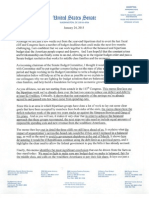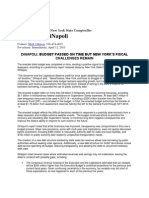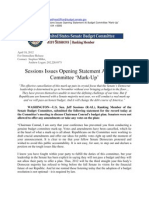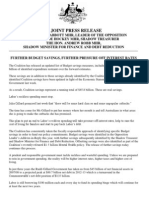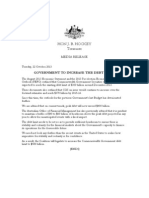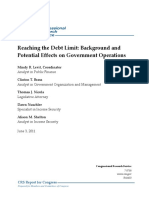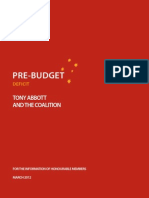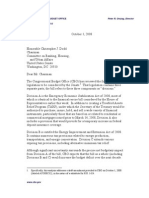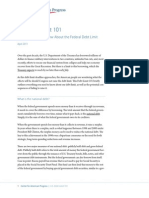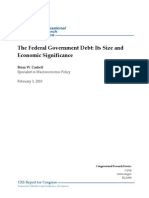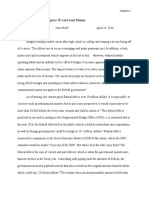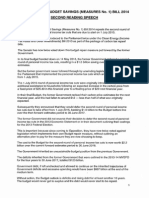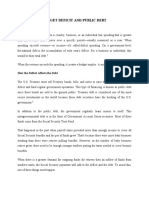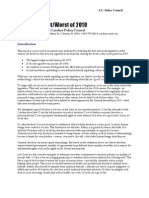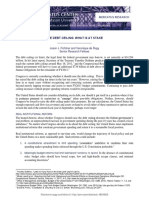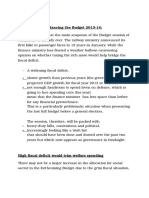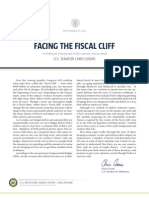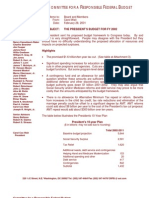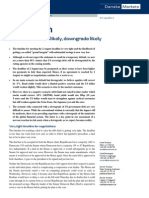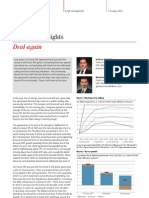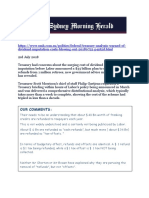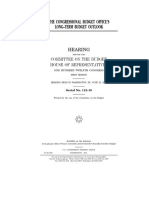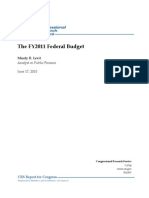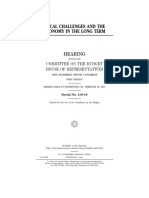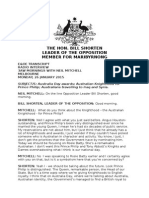Hon. J. B. Hockey Treasurer: Media Release
Hon. J. B. Hockey Treasurer: Media Release
Uploaded by
Political AlertCopyright:
Available Formats
Hon. J. B. Hockey Treasurer: Media Release
Hon. J. B. Hockey Treasurer: Media Release
Uploaded by
Political AlertOriginal Title
Copyright
Available Formats
Share this document
Did you find this document useful?
Is this content inappropriate?
Copyright:
Available Formats
Hon. J. B. Hockey Treasurer: Media Release
Hon. J. B. Hockey Treasurer: Media Release
Uploaded by
Political AlertCopyright:
Available Formats
HON. J. B.
HOCKEY Treasurer Media Release
Wednesday, 4 December 2013
STATEMENT ON COMMONWEALTH DEBT LIMIT
The Government has today agreed to the Australian Greens proposal to repeal the statutory debt limit and enhance transparency around government debt reporting. We have resolved this issue, after good faith and reasonable negotiations, and now can provide certainty to the markets about the Governments capacity to finance the budget. We have done this with no thanks to the Australian Labor Party, who created the debt and did nothing to find a solution as we approached the binding limit. Labor has said they will oppose their own savings the hypocrisy is breathtaking. The Labor Party created the debt target in 2008 of $75 billion; then they had to reset it over and over and over again to end up with the current $300 billion. The former Labor Governments own Budget documents confirmed that the debt limit would reach its $300 billion limit in December 2013. In fact, former Treasurer Swan refused to take action, despite admitting that the debt limit would be reached. Both the 2013 Economic Statement and 2013 Pre-Election Economic and Fiscal Outlook (PEFO), confirmed the Budget position had deteriorated from the Budget handed down in May, by more than $30 billion over the forward estimates period. The Australian Office of Financial Management (AOFM) previously advised and Treasurer Swan tabled their advice on May 10, 2012 that any debt limit set by the Government, should accommodate a buffer of between $40 billion and $60 billion higher than the peak projected within-year-peak of Commonwealth Government Securities on issue. Labor, now in Opposition, said it would not pass a debt limit of $500 billion, opting only for an increase of $400 billion. They refused Government and Treasury briefings. Recent events in the United States should have served as a warning sign. In fact Treasury Secretary, Dr Martin Parkinson, confirmed this in evidence to Senate Estimates in November when he said: We previously anticipated the peak plus the within-year buffer are to exceed $430 billion. It is now highly likely the quantum required will significantly exceed that amount. As such, the choice of a $500 billion limit seems prudent, if we are to place a premium on ensuring financial market confidence. (Source: Secretary Parkinson, Senate Estimates, 20 November 2013)
Were we to settle on a debt limit that was less than the anticipated prudent amount, it would be entirely reasonable for financial market participants here and overseas to wonder what might happen when what was clearly inevitable on current pathways came to occur. (Source: Secretary Parkinson, Senate Estimates, 20 November 2013) Today we are removing the instrument for parliamentary brinkmanship introduced by Labor when they created a legislative limit. The debt limit was an artificial construct that never constrained Labors spending. The absence of a limit does not mean that the Government will not be prudent and responsible. We have a clear plan to fix the budget and return to surplus when possible. This is the mandate on which we were elected and are accountable to the Australian Parliament and people. As part of the agreement with the Greens, we will implement measures to enhance transparency around government debt in the budget papers. Parliamentary debates on government debt will occur at least twice a year, and more often if debt is increasing by $50 billion or more. There will be a Debt Statement published in every Budget, every Mid-Year Economic and Fiscal Outlook and every PEFO. These Debt Statements will include the following information about Commonwealth stock and securities on issue, at the time of the report, for the financial year to which the report relates and for the following three financial years:
the value of Commonwealth stock and securities (including their market and face value, and their value as a proportion of gross domestic product); the total expected interest expenses relating to the stock and securities; and a breakdown, by maturity and interest payments, of the stock and securities on issue at the time of the report.
An Additional Debt Statement would also be published should debt increase by $50 billion or more since the last Debt Statement or Additional Statement was made. These Additional Debt Statements would set out the reasons for the increase in debt including the extent to which the increase was caused by lower than expected revenue, higher than expected spending, capital purchases and/or grants to State and Territory governments for infrastructure. We commend the Greens for coming to the table with sensible proposals to enhance transparency around government debt over time and working with the Government to provide the certainty to the financial markets that Labor failed to provide as they should have. [ENDS]
You might also like
- Tongue Diagnosis PDFDocument1 pageTongue Diagnosis PDFYo DraNo ratings yet
- Entrepreneurship-1112 Q2 SLM WK7Document8 pagesEntrepreneurship-1112 Q2 SLM WK7April Jean Cahoy56% (9)
- 6ly3 SeriesDocument390 pages6ly3 Seriesabduallah muhammad100% (3)
- Senator Murray Budget Memo 1-24Document12 pagesSenator Murray Budget Memo 1-24Ezra Klein100% (1)
- Debt Limit Second ReadingDocument2 pagesDebt Limit Second ReadingPolitical AlertNo ratings yet
- Australia: Open For BusinessDocument7 pagesAustralia: Open For Businessapi-81108585No ratings yet
- Joe Hockey Costings ResponseDocument4 pagesJoe Hockey Costings ResponsePolitical AlertNo ratings yet
- Usa Debt Crisis Republicans ViewDocument6 pagesUsa Debt Crisis Republicans ViewAmit Kumar RoyNo ratings yet
- US Debt CeilingDocument2 pagesUS Debt CeilingmathiarasuNo ratings yet
- Hon. J.B. Hockey MP The Hon. Senator Mathias CormannDocument2 pagesHon. J.B. Hockey MP The Hon. Senator Mathias CormannPolitical AlertNo ratings yet
- Enacted Budget Report 041213 FINAL2Document2 pagesEnacted Budget Report 041213 FINAL2jspectorNo ratings yet
- Sessions Issues Opening Statement at Budget Committee Mark-UpDocument4 pagesSessions Issues Opening Statement at Budget Committee Mark-Upapi-127658921No ratings yet
- Debt As Bargain CounterDocument2 pagesDebt As Bargain CounterGagandeep SinghNo ratings yet
- The Debt Limit: History and Recent Increases: D. Andrew AustinDocument27 pagesThe Debt Limit: History and Recent Increases: D. Andrew AustinGaryNo ratings yet
- Further Budget SavingsDocument2 pagesFurther Budget SavingsPeter MartinNo ratings yet
- Debt LimitDocument1 pageDebt LimitPolitical AlertNo ratings yet
- A DECADE OF SQUANDERED OPPORTUNITY by JM MinorDocument55 pagesA DECADE OF SQUANDERED OPPORTUNITY by JM MinorDesmond Sullivan100% (1)
- Ortgaging: UR UtureDocument5 pagesOrtgaging: UR UturereasonorgNo ratings yet
- Reaching The Debt Limit: Background and Potential Effects On Government OperationsDocument25 pagesReaching The Debt Limit: Background and Potential Effects On Government OperationsSeaLinc2No ratings yet
- Opposition Pre-Budget DeficitDocument12 pagesOpposition Pre-Budget DeficitLatika M BourkeNo ratings yet
- NPC AddressDocument15 pagesNPC AddressPolitical AlertNo ratings yet
- Peter R. Orszag, Director U.S. Congress Washington, DC 20515Document10 pagesPeter R. Orszag, Director U.S. Congress Washington, DC 20515Gordon NicolNo ratings yet
- Debt Limit 101Document5 pagesDebt Limit 101Center for American ProgressNo ratings yet
- Plan To Payoff Lab Debt 2009Document16 pagesPlan To Payoff Lab Debt 2009Peter MartinNo ratings yet
- OND Choeneck ING PLLC: MemorandumDocument17 pagesOND Choeneck ING PLLC: MemorandumrkarlinNo ratings yet
- 09.07.12 JPM Fiscal Cliff White PaperDocument16 pages09.07.12 JPM Fiscal Cliff White PaperRishi ShahNo ratings yet
- 02004-Factsheet 010307Document2 pages02004-Factsheet 010307losangelesNo ratings yet
- Federal DebtDocument14 pagesFederal Debtabhimehta90No ratings yet
- Issue BriefDocument14 pagesIssue Briefapi-316754061No ratings yet
- Replacing The SequesterDocument6 pagesReplacing The SequesterCenter for American ProgressNo ratings yet
- Labor 2013-14 Budget Savings (Measures No.1) Bill 2014 Second Reading SpeechDocument4 pagesLabor 2013-14 Budget Savings (Measures No.1) Bill 2014 Second Reading SpeechPolitical AlertNo ratings yet
- Budget of the U.S. Government: A New Foundation for American Greatness: Fiscal Year 2018From EverandBudget of the U.S. Government: A New Foundation for American Greatness: Fiscal Year 2018No ratings yet
- Federal Budget Sequestration 101: Perspectives Through The County LensDocument31 pagesFederal Budget Sequestration 101: Perspectives Through The County LenslaedcpdfsNo ratings yet
- Budget Deficit and Public DebtDocument3 pagesBudget Deficit and Public DebtFaisal AwanNo ratings yet
- Best/Worst of 2010: South Carolina Policy CouncilDocument47 pagesBest/Worst of 2010: South Carolina Policy CouncilSteve CouncilNo ratings yet
- Current Events PresentationDocument11 pagesCurrent Events Presentationtestk411No ratings yet
- Campaign Media Releas4Document2 pagesCampaign Media Releas4Political AlertNo ratings yet
- 2011 EUA Crise Teto Da DívidaDocument12 pages2011 EUA Crise Teto Da DívidaGabriel LaguerraNo ratings yet
- House Hearing, 110TH Congress - Department of Health and Human Services Fiscal Year 2008 Budget RequestDocument56 pagesHouse Hearing, 110TH Congress - Department of Health and Human Services Fiscal Year 2008 Budget RequestScribd Government DocsNo ratings yet
- Budget of The United States GovernmentDocument7 pagesBudget of The United States GovernmentTina Brown Mundy100% (1)
- 09-18-09 OSPB Letter To Agencies PDFDocument2 pages09-18-09 OSPB Letter To Agencies PDFArizonaMilitiaNo ratings yet
- SSRN Id1854963Document4 pagesSSRN Id1854963Gia HuyNo ratings yet
- Background of Balancing The Budget 2013-14:: Fiscal Deficit GDPDocument9 pagesBackground of Balancing The Budget 2013-14:: Fiscal Deficit GDPchengadNo ratings yet
- Research Paper 4Document16 pagesResearch Paper 4samzolfusaNo ratings yet
- What We Hope To See From Super CommitteeDocument18 pagesWhat We Hope To See From Super CommitteeCommittee For a Responsible Federal BudgetNo ratings yet
- Facing The Fiscal CliffDocument4 pagesFacing The Fiscal Clifflps2001No ratings yet
- Setting The Right Course in The Next Budget AgreementDocument30 pagesSetting The Right Course in The Next Budget AgreementCenter for American ProgressNo ratings yet
- ArticleDocument4 pagesArticleSteveNo ratings yet
- Running Out of Other People's Money: It's The Entitlements, StupidDocument4 pagesRunning Out of Other People's Money: It's The Entitlements, StupidLatinos Ready To VoteNo ratings yet
- Hon. J.B. Hockey: Minister For Finance Acting Assistant TreasurerDocument15 pagesHon. J.B. Hockey: Minister For Finance Acting Assistant TreasurerPolitical AlertNo ratings yet
- The Annapolis Report: A Review of The 2012 Legislative Session and Special SessionsDocument14 pagesThe Annapolis Report: A Review of The 2012 Legislative Session and Special SessionsmarknewgentNo ratings yet
- Update 2 28 01Document9 pagesUpdate 2 28 01Committee For a Responsible Federal BudgetNo ratings yet
- Danske Markets - US Debt Default Unlikely 20110727Document10 pagesDanske Markets - US Debt Default Unlikely 20110727SynergyFinanceNo ratings yet
- UBSeconomist-insights7 January2Document2 pagesUBSeconomist-insights7 January2buyanalystlondonNo ratings yet
- The Freedom Agenda: Why a Balanced Budget Amendment is Necessary to Restore Constitutional GovernmentFrom EverandThe Freedom Agenda: Why a Balanced Budget Amendment is Necessary to Restore Constitutional GovernmentNo ratings yet
- 2010 Albany BudgetDocument187 pages2010 Albany BudgettulocalpoliticsNo ratings yet
- SMH 23jul18Document5 pagesSMH 23jul18John GriffithNo ratings yet
- House Hearing, 112TH Congress - The Congressional Budget Office's Long-Term Budget OutlookDocument64 pagesHouse Hearing, 112TH Congress - The Congressional Budget Office's Long-Term Budget OutlookScribd Government DocsNo ratings yet
- The FY2011 Federal BudgetDocument24 pagesThe FY2011 Federal BudgetromulusxNo ratings yet
- Fiscal Challenges and The Economy in The Long Term: Hearing Committee On The Budget House of RepresentativesDocument54 pagesFiscal Challenges and The Economy in The Long Term: Hearing Committee On The Budget House of RepresentativesScribd Government DocsNo ratings yet
- Responsible Approaches To Increasing The Debt Limit February 7, 2011Document4 pagesResponsible Approaches To Increasing The Debt Limit February 7, 2011Committee For a Responsible Federal BudgetNo ratings yet
- Hockey - Reform SummitDocument4 pagesHockey - Reform SummitPolitical AlertNo ratings yet
- The Hon Bill Shorten MPDocument7 pagesThe Hon Bill Shorten MPPolitical AlertNo ratings yet
- The Hon Bill Shorten MPDocument22 pagesThe Hon Bill Shorten MPPolitical AlertNo ratings yet
- Speech On Marriage Amendment (Marriage Equality) Bill 2015Document6 pagesSpeech On Marriage Amendment (Marriage Equality) Bill 2015Stephanie AndersonNo ratings yet
- 10 Facts About Richard Di NataleDocument4 pages10 Facts About Richard Di NatalePolitical AlertNo ratings yet
- Media Release - Smaller Government - Transforming The Public SectorDocument6 pagesMedia Release - Smaller Government - Transforming The Public SectorPolitical AlertNo ratings yet
- Media Release - Smaller Government - Transforming The Public SectorDocument6 pagesMedia Release - Smaller Government - Transforming The Public SectorPolitical AlertNo ratings yet
- 15-02-27 Doorstop Interview Auckland New ZealandDocument3 pages15-02-27 Doorstop Interview Auckland New ZealandPolitical AlertNo ratings yet
- 107S1003Document6 pages107S1003Political AlertNo ratings yet
- PM TreasurerDocument10 pagesPM TreasurerPolitical AlertNo ratings yet
- National Security Statement, CanberraDocument9 pagesNational Security Statement, CanberraPolitical AlertNo ratings yet
- The Hon. Bill Shorten Leader of The Opposition Member For MaribyrnongDocument3 pagesThe Hon. Bill Shorten Leader of The Opposition Member For MaribyrnongPolitical AlertNo ratings yet
- Shorten SpeechDocument5 pagesShorten SpeechPolitical AlertNo ratings yet
- Today Show TranscriptDocument5 pagesToday Show TranscriptPolitical AlertNo ratings yet
- 14-12-23 Press Conference SydneyDocument3 pages14-12-23 Press Conference SydneyPolitical AlertNo ratings yet
- The HonDocument5 pagesThe HonPolitical AlertNo ratings yet
- Hockey Interview - Sky NewsDocument12 pagesHockey Interview - Sky NewsPolitical AlertNo ratings yet
- Hon. J.B. Hockey: Minister For Finance Acting Assistant TreasurerDocument15 pagesHon. J.B. Hockey: Minister For Finance Acting Assistant TreasurerPolitical AlertNo ratings yet
- The Hon Bill Shorten MPDocument6 pagesThe Hon Bill Shorten MPPolitical AlertNo ratings yet
- Brigada Eskwela CoordinatorDocument10 pagesBrigada Eskwela CoordinatorMargie Macam RodriguezNo ratings yet
- Fire Must Be Kept BurningDocument6 pagesFire Must Be Kept BurningAGNESNo ratings yet
- Actividad EnzimaticDocument11 pagesActividad EnzimaticherfuentesNo ratings yet
- Laxatives & Antidiarrheals UseDocument19 pagesLaxatives & Antidiarrheals UseDhurjati MajumdarNo ratings yet
- XI Chemistry Study Materials Class XI 281022 221029 203855-1Document187 pagesXI Chemistry Study Materials Class XI 281022 221029 203855-1Charvi100% (1)
- Contraceptive Comparison ChartDocument1 pageContraceptive Comparison ChartdryasirsaeedNo ratings yet
- SA July 2023 EditionDocument104 pagesSA July 2023 EditionVignesh A KNo ratings yet
- L14T8DF440 Ga2Document6 pagesL14T8DF440 Ga2SergioNo ratings yet
- Chimica Organica in IngleseDocument5 pagesChimica Organica in IngleseGreta PedersoliNo ratings yet
- Remembering Your Past Lives Using Candles and MeditationDocument6 pagesRemembering Your Past Lives Using Candles and Meditationhttp://www.whatis-theplan.org/No ratings yet
- Food Defense PolicyDocument4 pagesFood Defense PolicyRodolfoNo ratings yet
- Towards Protection of Children Against Sexual Abuse: No Child'S PlayDocument16 pagesTowards Protection of Children Against Sexual Abuse: No Child'S PlayRavindra SinghNo ratings yet
- Application For The Best Junior Commissioned Police OfficerDocument37 pagesApplication For The Best Junior Commissioned Police OfficerChristelle de los CientosNo ratings yet
- The Life and Teachings of Hazarath Tajuddin BabaDocument50 pagesThe Life and Teachings of Hazarath Tajuddin BabaYatendra KumarNo ratings yet
- Coconut Export: Members: Baterna, Alvin D. Bation, Jashmine Elleso, Kate Angel Hernane, Shiela Mae Trimidal, Precy JoyDocument5 pagesCoconut Export: Members: Baterna, Alvin D. Bation, Jashmine Elleso, Kate Angel Hernane, Shiela Mae Trimidal, Precy Joykateangel ellesoNo ratings yet
- 608 Plaintiff's Motion To Enforce Order Graanting Writ, 11.05.2020Document7 pages608 Plaintiff's Motion To Enforce Order Graanting Writ, 11.05.2020lschneider68No ratings yet
- Halliburton Reservoir Description Tool (RDT™) Formation TesterDocument1 pageHalliburton Reservoir Description Tool (RDT™) Formation TesterAnonymous xFfZQiNo ratings yet
- Muscle Milk Objection Final WC 030514Document26 pagesMuscle Milk Objection Final WC 030514Will ChamberlainNo ratings yet
- 6 Best Colognes For Men in 2024 Discover MagaziDocument1 page6 Best Colognes For Men in 2024 Discover MagaziRabihNo ratings yet
- Bosh Motronic ME 7.1.1Document99 pagesBosh Motronic ME 7.1.1Gustavo Amoros0% (2)
- TPoints RedemptionDocument36 pagesTPoints RedemptionYASSNo ratings yet
- MKSAP13-Cardiovascular MedicineDocument102 pagesMKSAP13-Cardiovascular MedicineManisha DesaiNo ratings yet
- Determinacion de Acidos GrasosDocument24 pagesDeterminacion de Acidos GrasosJefferson Roy Mego EnriquezNo ratings yet
- PEDIS Classification in Diabetic Foot Ulcers Patients PDFDocument5 pagesPEDIS Classification in Diabetic Foot Ulcers Patients PDFDeo ValendraNo ratings yet
- Thesis Statement For Nickel and DimedDocument8 pagesThesis Statement For Nickel and Dimedafkntwbla100% (2)
- Fall Dateline 2007Document24 pagesFall Dateline 2007indydentalsocietyNo ratings yet
- Pokemon Learning League NutritionDocument76 pagesPokemon Learning League NutritionTimothy WhitfieldNo ratings yet



